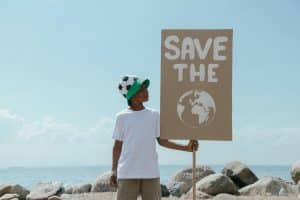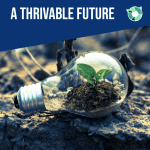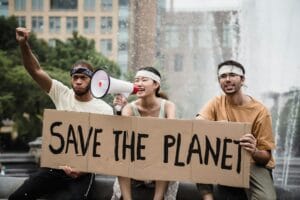Case File #HS-014
Crime Scene, Earth
I arrived at the site at dawn, the air still and grey. An excavation team had uncovered a peculiar cross-section of earth in what used to be a coastal city. In this stratigraphic layer, a dark band stood out. I knelt and brushed away centuries of dust to reveal several pieces of evidence: a human skull, sun bleached and half-buried in clay, surrounded by fragments of plastic and bone. A brittle plastic bottle stuck out of the dirt to the left of the skull, its label faint and faded. Just above, a chicken’s femur lay fossilised, unnaturally large for such a bird, emphasising its role as a creature forcibly bred for human consumption (Hood, 2023).
I lit a cigarette (a habit picked up from studying these ancient humans) and exhaled into the morning fog. Homo Sapiens, I mused. The dominant species of the Anthropocene, the era with the most lasting human impact, vanished without a trace of survivors (Macfarlane, 2016). Cause of death: asphyxiation by several Complex Wicked Problems and the humans’ inability to look beyond the impact of their businesses on shareholders; that is, Financial Materiality.
Investigative Overview
I would study each layer of sediment carefully, and hopefully solve the mystery at the heart of the disappearance of humans. I pulled out my notebook and began scribbling. The plastic bottle in the layer winked up at me, stubbornly intact. That would be Case Note 1: the tale of plastic and persistence. A few meters above, charred tree rings and pollen analysis hinted at a sudden fever in Earth’s climate. This would be Case Note 2: Heat Spike.
The absence of bird bones and bee exoskeletons in this layer spoke volumes of Case Note 3, the Great Silence that fell over the biosphere. And buried deeper in archives (the digital fossils we’d recovered from their data vaults) were hints of the true villains: callous economic logic, political inertia, willful denial. This would be Case Note 4: The Motive.
I stubbed out the cigarette on a shard of concrete embedded in the dirt. Time to compile the forensic report on the vanished species. I flipped to a fresh page in the case file and began transcribing the clues, one layer at a time.
Case Note 1: Plastics and Persistence
Evidence Item: Fragment of a polyethylene terephthalate bottle, circa 21st century, recovered in the stratum. Mint-green and un-degraded.
I turn the plastic shard between my gloved fingers. It’s astonishingly well-preserved; not even jagged around the edges. Plastics, as I recall from the historical literature, were the hallmark of human convenience, and their curse. Early 21st-century records warned that plastic takes more than 400 years to break down (Parker, 2018). In the comfort of buried landfills and ocean sediments, hidden from ultraviolet light, that lifespan extends even further. Indeed, plastiglomerates, the fused rock-plastic hybrids I see here, may last for millennia.

Source: Trinastic, 2015
Humanity’s reliance on plastic was almost absolute. Case files show that by the mid-20th century, mass production of plastics had accelerated exponentially. Factories churned out everything from single-use packaging to durable goods, billions of tonnes of it.
What happened to the plastic?
What truly interests us forensic folk is the fate of all that material. Data from 2015 indicates 8.3 billion metric tons of plastic had been produced in total, and 79% of it accumulated as waste in landfills or the natural environment (Parker, 2018). In other words, nearly four-fifths of all plastic ever made was just left to linger.
Some was incinerated (adding its toxins to the air), a fraction recycled, but most simply persisted as litter and debris. Over time, that debris fragmented into microplastics that infiltrated every corner of the planet: from Arctic ice to the guts of seabirds (Arctic Council, n.d.). It’s no surprise I find plastic in these soil layers; Earth’s strata were becoming a trash archive of the human era.
Back when they walked the Earth, humans themselves were ingesting and inhaling microplastics without fully understanding the consequences. We’ve found references to plastic particles in the food chain, even in drinking water. One chilling projection from their time: by mid-21st century, the oceans would contain more plastic waste than fish (by mass) (Parker, 2018).
Plastic and Human Extinction
I bag the bottle fragment as Exhibit #PP-21 (Plastic Persistence, 21st cent.). The stratigraphic layer tells us this artifact could be from around the early 2000s, give or take.
They wanted everything to last forever, I think, as I label the bag, and in a way, they got their wish. This plastic will outlive us all, sitting here in the dirt long after the last human drawing breath. It’s durable evidence that the crime happened, that humans messed with Earth’s chemistry and left an indelible mark. I flick on my recorder and state:
“Case Note 1 complete: Humans flooded their environment with synthetic polymers that do not decompose on human timescales. Result: a planetary layer of plastic debris.“
The next clue is tugging at my sleeve, a thermal anomaly in the data, a spike of carbon in the air samples from ice cores. Time to examine the heat spike that cooked the world.
Case Note 2: The Heat Spike
Evidence Item: Polar ice core data and climate records, 20th–23rd century. Shows a rapid rise in CO₂ and global temperatures. Back at headquarters, I spread graphs and core samples across the table under a flickering fluorescent light. It feels like performing an autopsy on the entire planet.
One graph, colloquially dubbed the “Hockey Stick” by the ancients, shows global temperature running almost flat for millennia, then jagging upward in the familiar shape of a hockey stick.

Source: Mooney, 2013
The culprit: atmospheric carbon dioxide (CO₂) and other greenhouse gases skyrocketing owing to human industry. The forensic evidence is unambiguous. By the year 2020, CO₂ concentration hit ~420 parts per million, a level the Earth had not seen in roughly 14 million years (Ahmed, 2023).
The fever that broke the planet
The crime here is climate change, a rapid forcing of Earth’s system by greenhouse gas emissions. And “rapid” is putting it mildly. Natural climate shifts (say, coming out of an ice age) usually unfolded over millennia with CO₂ ticking up at a rate of maybe 0.01 ppm per year. During the Anthropocene, CO₂ was leaping 2-3 ppm per year, a rate 100 to 200 times faster than during the transition from the last Ice Age (Kahn, 2017). Small wonder the geological record of the 21st century is marked by chaos: flash floods and droughts (evidenced by sediment deposits), megafire charcoal layers, and coral die-off in the reefs. The planet’s fever rose about 1.2°C above pre-industrial levels by the early 2020s (Ahmed, 2023).
This ‘heat spike’ manifests as a defining feature of the Anthropocene layer, likely contributing to widespread habitat loss, sea-level rise, and climatic volatility that stressed human societies to the breaking point. The planet got hotter, weather got wilder, and food systems likely began to fail (farms withered in drought or washed away in floods). It paints a picture of a species inadvertently turning the knobs of Earth’s thermostat into the red, then struggling in vain to survive the consequences. I report in the case file:
“Case Note 2 complete: Evidence confirms a pronounced climate warming event. CO₂ and methane concentrations jumped drastically, correlating with industrial activity.”
I lean back and rub my temples. The climate angle is heavy, but it’s only part of the story. The next note is even more unsettling in some ways: the silence that spread as living networks collapsed. If climate change was the dramatic fire, biodiversity loss was the slow suffocation. Time to examine who (or rather what) died off when humanity fell.
Case Note 3: The Great Silence
Evidence Item: Fossil record of insects, birds, and plant pollen; biodiversity archives.
The dawn chorus, that’s what they used to call the symphony of birds at sunrise. By the end, that music had faded to a whisper and then to nothing at all. In my investigation, I walk through an ancient forest (now eerily quiet) where no birds sing and no bees buzz. This is the sound of “The Great Silence”, the collapse of biodiversity that accompanied humanity’s demise.
The Collapse of the Pollinators
It started with the insects. Entomologists of the 2010s reported alarmingly steep declines in bug populations. One landmark study in Germany found a 76% drop in flying insect biomass in just 27 years (1989–2016) (Carrington, 2017). Insects form the foundation of food webs, pollinating plants, feeding birds, and breaking down organic matter. Strip them away, and ecosystems begin to unravel.
The case file shows that was already happening: butterfly counts were plummeting, fireflies blinking out, even the windshield phenomenon (where drivers noticed far fewer bug splats on cars in the 2010s than decades prior) became an anecdotal red flag. A United Nations (UN) assessment in 2016 warned that over 40% of invertebrate pollinator species (bees, butterflies, etc.) were threatened with extinction (Clark, 2016). Humans were effectively sawing off the branch they were sitting on, because 75% of global food crops depended on pollinators.
Then Came the Birds
Then there were the birds. I comb through data from North America: between 1970 and 2019, nearly 3 billion breeding adult birds disappeared from the continent’s skies. Forests lost 1 billion birds while grasslands lost another 720 million birds (Rosenberg et al., 2019). The warning came then, too:
“A staggering loss that suggests the very fabric of North America’s ecosystem is unraveling.”
–Cornell Lab director John Fitzpatrick and study coauthor Peter Marra
Our forensic clues point to multiple causes for this biosphere massacre, nearly all tracing back to human activity. Habitat destruction was a big one. Humans converted wilderness into farmland and cities at a breakneck pace, leaving ever-smaller islands for other life. By the early 21st century, human land use had directly altered over 75% of Earth’s land (mostly for agriculture).

Forests were felled (the Amazon, Borneo, and Congo (bloodbaths of biodiversity), wetlands drained, and coral reefs bleached and broken. A planetary game of Jenga, removing block after block until the tower started to sway.
The Great Silence deepened as one species’ decline cascaded to the next. Ecologists call it trophic collapse: insects go, then the birds that eat them, then the predators that eat those birds, and so forth. Perhaps the most gut-wrenching statistic I log in this case note is a summary from a global assessment around 2019: One million species were at risk of extinction in the near term, many within decades (CNN, 2019). A report written by 145 experts around the world through the UN committee further highlighted that the rate of species extinction is “tens to hundreds of times higher than it has been, on average, over the last 10 million years” (IPbes, 2019).
The loudness of the Silence
Standing in that quiet forest, I close my eyes and imagine the choir that once was: the thrum of cicadas on a hot day, the peeper of frogs at dusk, and the riot of bird calls at dawn. These were the sounds of a living world in balance. The silence now is the loudest evidence of how thoroughly Homo sapiens unravelled the web of life. The tragedy was not just that humans vanished, but that they took so much of the tapestry of life with them.
I note in the file:
“Case Note 3 summary: Widespread biodiversity collapse coincided with human extinction. The planet’s biosphere, severely degraded, could no longer support the human population, nor countless other creatures. This Great Silence marks the final chapter of the Anthropocene’s living world.”
The evidence is overwhelming, but a question nags at me: Why? Why did it come to this? The humans weren’t ignorant; they saw these things happening. They had scientists, data, and warnings. So why did they fail to stop their own end? For that, I need to dig into motive: the psychology, the sociopolitical pathology that didn’t allow for change even as the house was burning down around them.
Case Note 4: The Motive
Investigation Focus: Economic and political factors, disinformation campaigns, and policy failures that impeded action.
Every detective knows that understanding the motive can crack a case wide open. In the mystery of Homo sapiens’ disappearance, the motive is less a single smoking gun and more a complex web of greed, shortsightedness, and denial. A real Complex Wicked Problem, to say the least. By the 21st century, humans had built a global civilisation powered by fossil fuels and bound by the need for perpetual growth. That system brought prosperity for some, but at the cost of the natural world’s degradation. Too much attention on Financial Materiality, and not enough on Impact Materiality; in short, caring about shareholders over environment and/or people.
Why didn’t they change course when the warnings became dire? The case file is thick with clues, including internal memos, public statements, and political decisions that, in retrospect, read like a litany of missed opportunities and willful negligence. I present a few key exhibits:
Exhibit A: Industry Doubt-Mongering
An internal memorandum from a coalition of fossil fuel companies (circa late 1990s) bluntly stated their communications goal: “Victory will be achieved when the average person is uncertain about climate science.” Millions were spent in an active attempt to sow doubt on climate science (Hall, 2015).
The fossil fuel industry’s motive was clear: delaying action preserved their profits. By the time the truth was undeniable, precious decades had been lost. Half of all human-produced CO₂ emissions were emitted after 1988 (Hall, 2015). This is an incredible fact considering that by 1988, the world already knew what those emissions would do. The inertia of money and power essentially tied humanity’s hands as the clock ran out.
Exhibit B: Political Inertia and Denial
In the halls of power, many leaders failed to lead. Some outright denied the problem. For instance, in 2017, the head of the U.S. Environmental Protection Agency (EPA), the very office meant to safeguard the environment, claimed he did not believe CO₂ was a primary driver of global warming (Kahn, 2017).
This statement flew in the face of scientific consensus and was objectively false, yet it signalled how deep the denial ran in certain political circles. High-profile politicians called climate change a “hoax” and rolled back environmental regulations. Even those who acknowledged the issue often treated it as low priority compared to economic growth or geopolitical squabbles. Every year of delay and denial was a year of mounting greenhouse gases and biodiversity losses. They kicked the can down the road…and straight off a cliff.
Exhibit C: Policy Failures
The world did attempt to coordinate on climate action with treaties like the Kyoto Protocol (1997) and the Paris Agreement (2015). But promises often rang hollow. In 2017, one of the world’s largest emitters, the United States, announced its withdrawal from the Paris Accord, citing “draconian financial and economic burdens” of the agreement (Garden, 2017).
Internationally, even countries that stayed in the agreement weren’t cutting emissions fast enough. The UNEP Emissions Gap reports repeatedly warned that current pledges put the world on track for a disastrous 2.5–3°C of warming, far above the 1.5°C goal that scientists said was a relatively safe limit. In simpler terms, there was a massive gap between rhetoric and action (UNEP, 2023).
Compiling the motive, an image emerges of a species caught in a cognitive dissonance. Humans prided themselves on rationality and innovation, yet when evidence showed that their way of life was unsustainable, powerful organisations and individuals chose to deny or delay. There was money to be made, elections to be won, comfort to be had, and changing course was inconvenient. Some humans, of course, fought valiantly for a different path: scientists, activists, and forward-thinking leaders. But too often, they were shunned and ignored because of systemic inertia.
The Final Analysis
Homo sapiens were done in by a failure of collective action. I close Case Note 4 with the following conclusion:
“The extinction of Homo sapiens was not a random accident of fate; it was the predictable outcome of choices made and not made. The motive behind those choices is often traced to profit, power, and a willful ignorance. In effect, short-term gains were valued over long-term survival.”
The legacy of an extinction
The investigation concludes at the same place it began: the silent strata of Earth. In the layers of rock and ice, their story is written clearly for those who know how to read it. The humans did document their own rise and fall meticulously. In their final decades, they built a picture of their predicament. It’s almost as if they compiled a cautionary tale for whoever might follow. A message in a plastic bottle: “We knew, we failed to act, learn from us.”
My report, now complete, will be archived under “Anthropocene: Homo Sapiens’ Extinction Event”. The final entry reads: Cause of extinction: self-inflicted environmental collapse.
I pack up my notebook and tools at the edge of that silent forest. The sun is setting, casting golden light on a ruined skyline in the distance. Vines crawl up skeletal skyscrapers; a lone bird, perhaps a descendant of a pigeon, coos softly, a hopeful sign that life goes on.
Conclusion and Call to Action (CTA)
This article is meant to showcase the path that we, as humanity, are on; a frightening story with a very real conclusion. Although the topic of climate change, biodiversity loss, and overall environmental decline feels too overwhelming to tackle, ignoring it is not an option. Indeed, humanity’s survival is at stake.
We need to allow nature to regenerate, enable ecosystems to heal, mitigate the impact of greenhouse gas emissions, and ensure that business practices do not continue to infringe on the natural world. This is what Strong Sustainability is all about. If we continue to exploit non-renewable resources at the rate we do, then one day, the story you just read may indeed come to pass.
THRIVE Project Framework
THRIVE Project envisions a world where harmony exists between humanity and nature. The THRIVE Framework is an important part of this goal and allows sustainability approaches to be integrated in one clear template. A core part of this framework is the Foundational Focus Factors, such as Materiality, Complex Wicked Problems, and Strong Sustainability.
Materiality
Materiality refers to those things that are significant and relevant. It’s a guiding principle that reminds organisations to prioritise the right sustainability topics. Using this principle to make decisions that are positively impactful for the individuals and larger environments can drastically change the course of entire systems.
Complex Wicked Problem
Having said that, we can recognise that the issue of climate change and environmental well-being is a Complex Wicked Problem. It doesn’t have an easy solution, nor is it simple to solve. The context is large and systemic and requires a series of decisions and outputs that build on top of each other to create a better system. This is not an easy thing to do. Yet, it is important nonetheless. In the end, the only way to achieve any headway with a Complex Wicked Problem is to have the right priorities set from top to bottom and across various countries (i.e. Materiality).
Strong Sustainability
The concept of Strong Sustainability takes the above a step further. It focuses on maintaining AND furthering the flourishing of all of Earth’s ecosystems. It means that instead of merely trying to mitigate the worst impacts of climate change, we should be aiming for regeneration. Targeting levels of resource use that don’t go beyond regeneration levels is at the core of Strong Sustainability.
The United Nations’ Sustainable Development Goals do include SDG14: Life Below Water and SDG15: Life on Land; calling for conserving and sustainably managing oceans, seas, and land resources to avoid degradation and biodiversity loss (UN, n.d.). However, unlike THRIVE, most sustainability organisations focus on net-zero sustainability rather than positive thrivability. The point is not merely to co-exist and do no harm. We aim to cultivate a positive impact on the natural world around us.
Through research, education, and advocacy, we explore pathways that extend beyond sustainability toward thriving systems. So engage with our blogs, podcasts, and webinars, and subscribe to our newsletter for updates on the latest in sustainability news. Join our community and help drive the transition to a future where humanity and the planet flourish together.




















